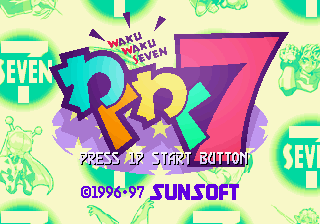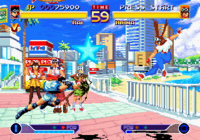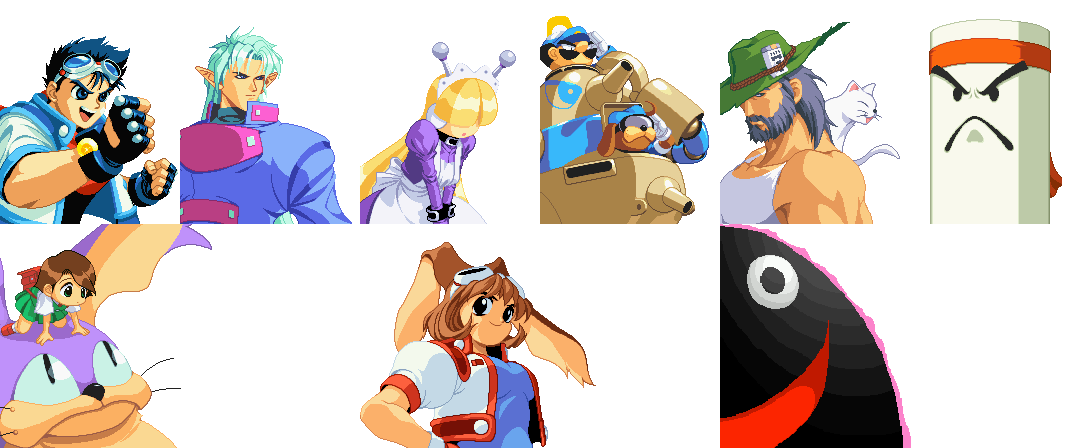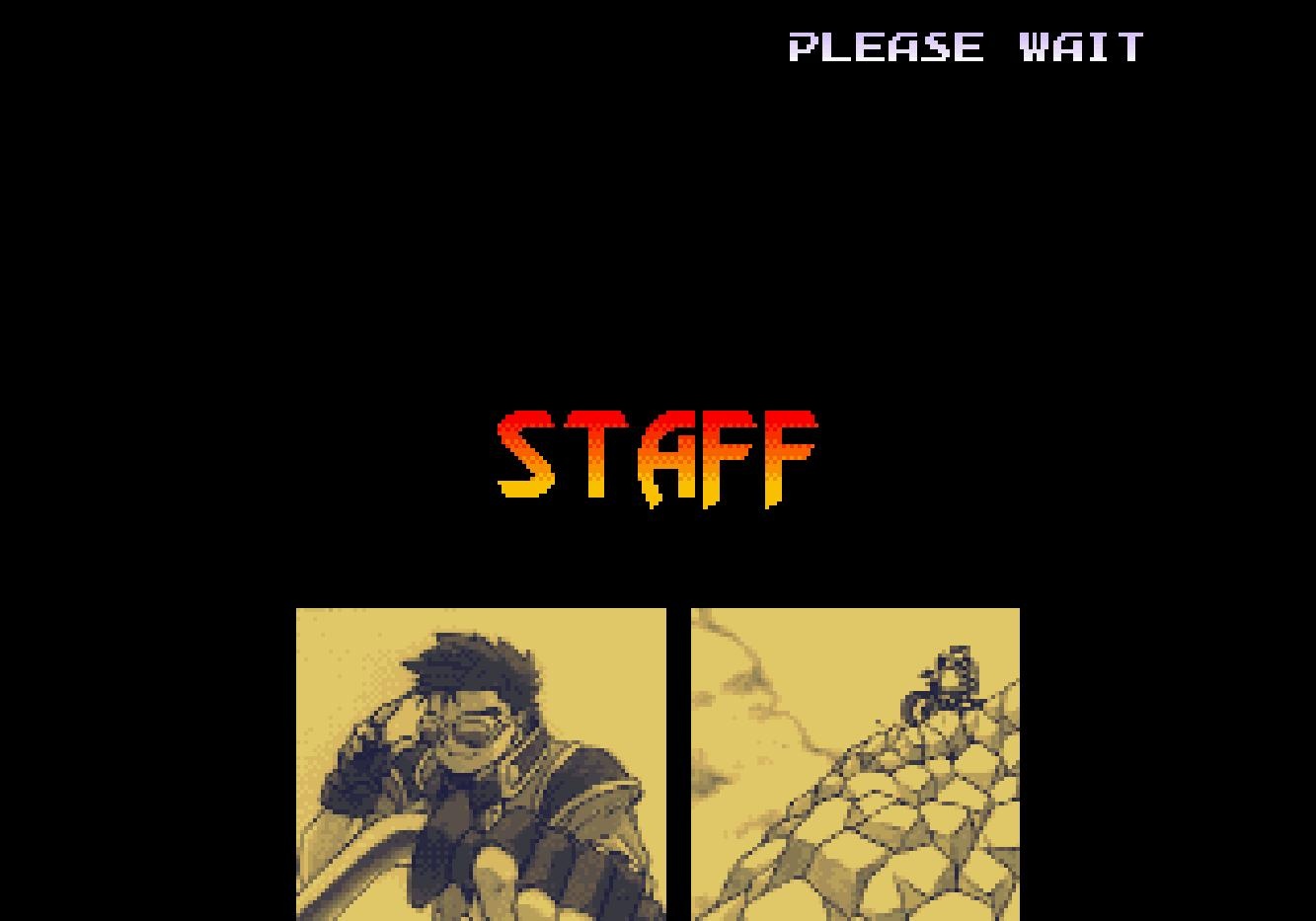Waku Waku 7
From Sega Retro
| Waku Waku 7 | |||||||||||||||
|---|---|---|---|---|---|---|---|---|---|---|---|---|---|---|---|
| System(s): Sega Saturn | |||||||||||||||
| Publisher: Sunsoft, Wooyoung System (KR) | |||||||||||||||
| Developer: Sunsoft | |||||||||||||||
| Original system(s): Neo Geo MVS | |||||||||||||||
| Sound driver: SCSP/CD-DA (44 tracks) | |||||||||||||||
| Peripherals supported: Extended RAM Cartridge (1MB/4MB) | |||||||||||||||
| Genre: Fighting Action/Kakutou Action (格闘アクション)[1], Action[2] | |||||||||||||||
| Number of players: 1-2 | |||||||||||||||
| |||||||||||||||
|
Waku Waku 7 (わくわく7) is a fighting game by Sunsoft. Originally for Neo Geo MVS arcade hardware, it was ported to the Sega Saturn in 1997. It was only released in Japan.
"Waku waku" is a Japanese onomatopoeia expressing excitement.
Contents
Story
According to legend, collecting all seven of the Waku Waku Balls grants any wish. Seven fighters have obtained one Waku Waku Ball apiece and now battle for the others.
Gameplay
Waku Waku 7 is a one-on-one fighting game. It is considered a "spiritual sequel" to Galaxy Fight, though it features an entirely new cast of characters (with the exception of the returning mid-boss Bonus-kun) and adopts the conventions of most other fighting games of the time (such as adopting a control scheme that splits attacks between punches and kicks, using finite scrolling stages with "walls," and adding a power gauge that can be used to perform "super" moves). Matches are fought to the best of three rounds, and each round is timed. If time runs out, the player with the most vitality remaining wins the round.
Characters move with ![]() and
and ![]() . They backstep or run with
. They backstep or run with ![]()
![]() or
or ![]()
![]() (and continue running until the direction is released). They crouch with
(and continue running until the direction is released). They crouch with ![]() and jump with
and jump with ![]() ,
, ![]() , or
, or ![]() . They attack by punching with
. They attack by punching with ![]() (light) or
(light) or ![]() (hard) and kicking with
(hard) and kicking with ![]() (light) or
(light) or ![]() (hard). Light attacks are fast but do little damage, while hard attacks are strong but slow. Characters can attack while standing, crouching, jumping, or dashing. Every character also has special moves that are performed with different button combinations. Projectile attacks can be dissipated by attacking them.
(hard). Light attacks are fast but do little damage, while hard attacks are strong but slow. Characters can attack while standing, crouching, jumping, or dashing. Every character also has special moves that are performed with different button combinations. Projectile attacks can be dissipated by attacking them.
Characters can block by holding the D-Pad away while the opponent is attacking. Blocked normal moves do no damage, but blocked special moves still do a small amount of damage. Characters can block while crouching or standing. Jumping attacks can only be blocked standing, and low or sweep attacks can only be blocked crouching. Every character can do an overhead attack, which can only be blocked standing, by pressing a punch and a kick button of the same strength (or ![]() ). Characters can become temporarily stunned by taking too much damage in a short period, but they can recover more quickly by pressing the attack buttons rapidly and rolling the D-Pad in circles.
). Characters can become temporarily stunned by taking too much damage in a short period, but they can recover more quickly by pressing the attack buttons rapidly and rolling the D-Pad in circles.
Characters can throw each other ![]() or
or ![]() when next to an opponent and pressing the medium or hard attack button. Some characters can also throw in midair by holding the D-Pad in any direction except
when next to an opponent and pressing the medium or hard attack button. Some characters can also throw in midair by holding the D-Pad in any direction except ![]() and pressing the hard punch button. Every character also has a command throw called a "Waku Waku Throw," which does more damage, that can be performed using a special button combination. Throws cannot be blocked. After being thrown, the character can recover more quickly (and avoid being knocked down) and take less damage by holding
and pressing the hard punch button. Every character also has a command throw called a "Waku Waku Throw," which does more damage, that can be performed using a special button combination. Throws cannot be blocked. After being thrown, the character can recover more quickly (and avoid being knocked down) and take less damage by holding ![]() and pressing any attack button. Downed opponents can be attacked by holding
and pressing any attack button. Downed opponents can be attacked by holding ![]() and pressing any attack button. When knocked down (from a throw or another attack), characters can recover more quickly by pressing the attack buttons rapidly, roll away by holding
and pressing any attack button. When knocked down (from a throw or another attack), characters can recover more quickly by pressing the attack buttons rapidly, roll away by holding ![]() or
or ![]() , or recover with an attack by holding
, or recover with an attack by holding ![]() . Some moves knock the opponent into the wall. After being knocked into a wall, the character can recover more quickly (and avoid being knocked down) by pressing a punch button to fall safely or a kick button to rebound with a counterattack.
. Some moves knock the opponent into the wall. After being knocked into a wall, the character can recover more quickly (and avoid being knocked down) by pressing a punch button to fall safely or a kick button to rebound with a counterattack.
Each character has a "Waku Waku Gauge" that fills as the character performs normal moves (with the gauge increasing a small amount if the attack misses, a larger amount if the attack is blocked, and the largest amount if the attack hits) and special moves (regardless of whether they hit the opponent) or blocks attacks. The gauge can hold multiple levels (depending on the player's progress in the single-player game or the maximum level chosen in two-player games) and gains a level whenever it is filled. Gauge levels are retained between rounds but not matches. There are several different types of super moves that can be performed, each costing one level of the gauge. Most special moves have an enhanced version that can be performed by pressing two punch or two kick buttons instead of only one (similar to the ES moves in the Darkstalkers games). Characters also have access to "Doki Doki attacks," which are unique super moves, and "Hara Hara attacks," which are super moves that are unblockable and do high damage but are preceded by a warning and a delay (during which they can be interrupted by the opponent by attacking). Finally, characters can enter "Super Mode" by holding any three attack buttons (or ![]() ), which causes the character to glow and temporarily enhances both attacks and defense.
), which causes the character to glow and temporarily enhances both attacks and defense.
Modes
In the single-player game, the player chooses from seven characters and fights a match against every other character in the game in a random order. Each opponent relinquishes a Waku Waku Ball once defeated, and each Waku Waku Ball collected increases the maximum level of the Waku Waku Gauge by one level for subsequent matches (for both the player and opponents). After three wins, there is a "Bonus Fight" against the unplayable character Bonus-kun (who does not possess a Waku Waku Ball). This match is fought with both combatants having seven Waku Waku Gauge levels, only consists of a single round, and does not have to be won to continue in the game. After defeating every other playable character and collecting all seven Waku Waku Balls, the character fights against a "shadow" version of himself or herself. Then the final boss Fernandeath escapes from the monument under which he has been trapped and grows to the size of a skyscraper. The fairy that imprisoned Fernandeath grows the player's character to equivalent size for the final match. Once defeated, the fairy grants the player's character a wish in the ending.
The game ends if the player loses a match but can be continued an unlimited number of times. A second player can enter the game for a two-player versus match by pressing START during gameplay. In the options, the player can choose from six difficulty levels for computer-controlled opponents (Limitter Cut, RakuRaku, Easy, Normal, Arcade, and WakuWaku), change the time limit for each round (30, 60, or 90 seconds or no limit), and choose how the Waku Waku Gauge is charged (Normal, starts at zero and fills normally; Full Normal, starts at maximum level and fills normally; Auto, starts at zero and fills automatically; Full Auto, starts at maximum level and fills automatically; Hyper, starts at zero and fills automatically very quickly; and Full Hyper, starts at maximum level and fills automatically very quickly).
There is also a dedicated two-player versus mode, which has four different sub-modes (human versus human, human versus computer, computer versus computer, and "Watch Mode," which is a computer versus computer mode where the characters are chosen randomly and the game keeps fighting matches indefinitely). Players can choose any characters (including the two boss characters), set individual handicaps, choose how the Waku Waku Gauge is charged, choose the maximum number of Waku Waku Gauge levels, and pick the stage.
Characters
Note: Move lists assume that the character is facing right. When facing left, ![]() and
and ![]() should be reversed.
should be reversed.
| P | Any punch button |
| LP | Light punch |
| HP | Hard punch |
| K | Any kick button |
| LK | Light kick |
| HK | Hard kick |
Pressing ![]() is equivalent to pressing LP + HP , and pressing
is equivalent to pressing LP + HP , and pressing ![]() is equivalent to pressing LK + HK .
is equivalent to pressing LK + HK .
Each character has four costume colors available, depending on which of the attack buttons is used to select them (with LP selecting the primary color scheme and HP selecting the secondary color scheme), plus a "shadow" color scheme only used for the mirror match opponent in the single-player game.
Playable
Waku Waku Ball: Red
|
Rai (ライ) | |||||||||||||||||
A delinquent school boy who rides a BMX bike and skips school to seek adventure. He resembles Sie Kensou from King of Fighters, and he has special moves similar to Terry Bogard from the Fatal Fury series.
| ||||||||||||||||||
Waku Waku Ball: Violet
|
Slash (スラッシュ) | |||||||||||||||||
A monster hunter who hunts demons who have escaped to the human world.
| ||||||||||||||||||
Waku Waku Ball: Yellow
|
Tesse (ティセ) | |||||||||||||||||
A robotic doll created to do housekeeping chores. She longs one day to become human.
| ||||||||||||||||||
Waku Waku Ball: Light Blue
|
Politank Z (ポリタンク Z) | |||||||||||||||||
A mecha created by the Waku Waku City police department and piloted by the two miniature policemen, Chojuro and Hamusuke.
| ||||||||||||||||||
Waku Waku Ball: Green
|
Marurun (まるるん) | |||||||||||||||||
A giant forest guardian who is trying to protect the young girl Mugi and return her to her parents. He resembles the title character of My Neighbor Totoro.
| ||||||||||||||||||
Waku Waku Ball: Dark Blue
|
Dandy J (ダンディーJ) | |||||||||||||||||
A veteran treasure hunter. After his partner goes missing, he begins training the partner's daughter, Natsumi, who appears with her pet cat, Ranpoo, in the background of the stage whenever Dandy J is fighting.
| ||||||||||||||||||
Waku Waku Ball: Orange
|
Arina (アリーナ) | |||||||||||||||||
An athletic school girl with bunny ears who is trying to find a boyfriend.
|
Bosses
The boss characters are playable in the two-player mode.
|
Bonus-kun (ボーナスくん) | |||||||||||||||||
An animated punching bag who wanders through space and time in search of stronger opponents. As in Galaxy Fight, he appears as a mid-boss halfway through the single-player game. His special moves and his theme music are inspired by Ryu from Street Fighter. He cannot crouch or throw.
| ||||||||||||||||||
|
Fernandeath (フェルナンデス) | |||||||||||||||||
A large and mysterious creature who was sealed away in Waku Waku Park by a fairy. When the player collects all seven Waku Waku Balls, he is released from the monument where he is sealed and grows to the size of a skyscraper for the final fight.
|
Stages
Every character has his or her stage where matches are fought in the single-player mode (except for Bonus-kun, who fights in the stage of the previously defeated character). The stage is chosen manually in the two-player mode.
Versions
The Saturn port is often considered an inferior version, as despite requiring an extra 1MB RAM cartridge, it offers more pixelated backgrounds and longer loading times than the Neo Geo version. It does, however, have an exclusive arranged soundtrack that was not used in any other version of the game.
Production credits
- Wakuwaku Programmer: Yuichi Ueda, Shige.Ytm.Inaba
- Wakuwaku Graphic Designer: Murakichi, Chupon, Kouki Kita, Toshihiko Narita, Yasuhide Maeda, Atsuki Matsui, Masashi Kajikawa, Takuro Nagai, Kazuhito Terada, Naoto Kunimori, Tatsuya Doe
- Wakuwaku Sound Designer: Kazuo Nii, Noriaki Urata
- Wakuwaku Music Composer: Masato Araikawa
- Wakuwaku Musician: Masayoshi Kondo, Hiroshi Koizumi, Andre Black, Yayoi Sakiyama, Eri Kusaka
- Wakuwaku Voice Actor & Actress: Yoko Okochi, Yoshinori Kudo, Mariko Masuda, Osamu Nakamoto, Tokishige Tsujimura, Ben Izawa, Toshiyuki Fujita, Kazunori Hotta, Chitose Omi, Naho Hattori, Yukitoshi Hirano
- Wakuwaku Music Coordinator: Atsushi Mihiro, Hideo Zaitsu
- Wakuwaku Director: Yuichi Ueda
- Special Thanks: Kazuyuki Watanabe, Naoki Kodaka, Kazuyo Umemura, Tatsuo Mori, Kazuko Harman, Naomi Sakaguchi, Megumi Masuko, Noriaki Kitamura, Sunsoft All Staff, And You!
Magazine articles
- Main article: Waku Waku 7/Magazine articles.
Promotional material
also published in:
- Game Champ (KR) #1997-09: "xxxx" (199x-xx-xx)[5]
- Game Champ (KR) #1997-10: "xxxx" (199x-xx-xx)[6]
also published in:
- Game Champ (KR) #1997-12: "xxxx" (199x-xx-xx)[7]
also published in:
- Game Champ (KR) #1998-02: "xxxx" (199x-xx-xx)[8]
Physical scans
| Sega Retro Average | ||||||||||||||||||||||||
|---|---|---|---|---|---|---|---|---|---|---|---|---|---|---|---|---|---|---|---|---|---|---|---|---|
|
| 65 | |
|---|---|
| Based on 4 reviews | |
| Saturn, KR |
|---|
|
Technical information
- Main article: Waku Waku 7/Technical information.
References
- ↑ File:WakuWaku7 Saturn JP Box Back.jpg
- ↑ 2.0 2.1 https://sega.jp/fb/segahard/ss/soft_licensee3.html (Wayback Machine: 2020-03-20 23:05)
- ↑ 3.0 3.1 3.2 Sega Saturn Magazine, "1997-13 (1997-04-25)" (JP; 1997-04-11), page 7
- ↑ File:WakuWaku7 Saturn JP SSEnding.pdf
- ↑ Game Champ, "xxxx" (KR; 199x-xx-xx), page 15
- ↑ Game Champ, "xxxx" (KR; 199x-xx-xx), page 5
- ↑ Game Champ, "xxxx" (KR; 199x-xx-xx), page 16
- ↑ Game Champ, "xxxx" (KR; 199x-xx-xx), page 4
- ↑ Famitsu, "1997-06-27" (JP; 1997-06-13), page 1
- ↑ Saturn Fan, "1997 No. 12" (JP; 1997-06-xx), page 179
- ↑ Sega Saturn Magazine, "1997-21 (1997-06-27)" (JP; 1997-06-13), page 156
- ↑ Sega Saturn Magazine, "Readers rating final data" (JP; 2000-03), page 14
| Waku Waku 7 | |
|---|---|
|
Main page | Comparisons | Hidden content | Magazine articles | Reception | Technical information
Demos: Waku Waku 7 Taikenban (1997) | |



























































